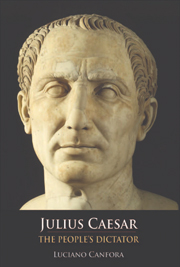Book contents
- Frontmatter
- Contents
- Translators' Note
- Acknowledgements
- Foreword
- PART I FROM SULLA TO CATILINE
- 1 In Flight from Sulla: First Experiences of an Aristocratic Youth
- 2 Prisoner of the Pirates (75–74 BC)
- 3 The Rise of a Party Leader
- 4 Pontifex Maximus
- 5 The ‘Affairs’ of Mr Julius Caesar and Others
- 6 The Political Market
- 7 Inside and Outside the Conspiracy
- 8 Caesar's Senate Speech Rewritten by Sallust
- PART II FROM THE TRIUMVIRATE TO THE CONQUEST OF GAUL
- PART III THE LONG CIVIL WAR
- PART IV FROM THE CONSPIRACY TO THE TRIUMPH OF CAESARISM
- Chronology
- Bibliography
- Index
7 - Inside and Outside the Conspiracy
from PART I - FROM SULLA TO CATILINE
Published online by Cambridge University Press: 05 August 2013
- Frontmatter
- Contents
- Translators' Note
- Acknowledgements
- Foreword
- PART I FROM SULLA TO CATILINE
- 1 In Flight from Sulla: First Experiences of an Aristocratic Youth
- 2 Prisoner of the Pirates (75–74 BC)
- 3 The Rise of a Party Leader
- 4 Pontifex Maximus
- 5 The ‘Affairs’ of Mr Julius Caesar and Others
- 6 The Political Market
- 7 Inside and Outside the Conspiracy
- 8 Caesar's Senate Speech Rewritten by Sallust
- PART II FROM THE TRIUMVIRATE TO THE CONQUEST OF GAUL
- PART III THE LONG CIVIL WAR
- PART IV FROM THE CONSPIRACY TO THE TRIUMPH OF CAESARISM
- Chronology
- Bibliography
- Index
Summary
Caesar's career was marked by two conspiracies: in one of them, which failed, he was a participant ‘from a distance’, or was at least aware of it; of the other, which succeeded, he was the target. He was on the fringes of the Catilinarian conspiracy, but he stood to be swept away by it. It was Cicero who came to his rescue. Somebody had produced documents, possibly not genuine, which seemed to implicate Caesar in the plot. Lucius Vettius, a Roman knight who in his youth had known Cicero at the time of the social war (89 bc: both had fought at Ascoli), later a friend of Catiline and a participant in the conspiracy, went over to the other side and denounced the plotters. He declared before the investigation carried out by Novius Niger that he was in possession of compromising letters to Catiline signed by Caesar. Caesar had in the meantime taken up the praetorship, and the accusation could have cost him his life: in January Catiline and his followers had fought with astonishing bravery against the army of the consuls at the battle of Pistoia in Tuscany. Caesar ‘appealed’, as Suetonius puts it, to Cicero for help. But that help, according to Suetonius, could not consist in proving that the documents were forged. The best that Cicero could do in response to Caesar's plea was to testify that Caesar had actually on his own initiative confided to the consul those details that he knew of the conspiracy months earlier, when the conspiracy was in train.
- Type
- Chapter
- Information
- Julius CaesarThe People's Dictator, pp. 39 - 53Publisher: Edinburgh University PressPrint publication year: 2007



